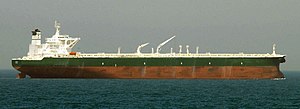Very Large Crude Carrier

The commercial oil tanker AbQaiq, in ballast
|
|
| Class overview | |
|---|---|
| Name: | Oil tanker |
| Subclasses: |
Handysize, Panamax, Aframax, Suezmax, Very large crude carrier (VLCC), Ultra large crude carrier (ULCC),Ti class (ti) |
| Built: | c. 1963–present |
| General characteristics | |
| Class and type: | Tank ship |
| Capacity: | up to 550,000 DWT |
| Notes: | Rear house, full hull, midships pipeline |
Handysize, Panamax, Aframax, Suezmax, Very large crude carrier (VLCC),
An oil tanker, also known as a petroleum tanker, is a merchant ship designed for the bulk transport of oil. There are two basic types of oil tankers: crude tankers and product tankers. Crude tankers move large quantities of unrefined crude oil from its point of extraction to refineries. Product tankers, generally much smaller, are designed to move refined products from refineries to points near consuming markets.
Oil tankers are often classified by their size as well as their occupation. The size classes range from inland or coastal tankers of a few thousand metric tons of deadweight (DWT) to the mammoth ultra large crude carriers (ULCCs) of 550,000 DWT. Tankers move approximately 2,000,000,000 metric tons (2.2×109 short tons) of oil every year. Second only to pipelines in terms of efficiency, the average cost of oil transport by tanker amounts to only two or three United States cents per 1 US gallon (3.8 L).
Some specialized types of oil tankers have evolved. One of these is the naval replenishment oiler, a tanker which can fuel a moving vessel. Combination ore-bulk-oil carriers and permanently moored floating storage units are two other variations on the standard oil tanker design. Oil tankers have been involved in a number of damaging and high-profile oil spills. As a result, they are subject to stringent design and operational regulations.
The technology of oil transportation has evolved alongside the oil industry. Although anthropogenic use of oil reaches to prehistory, the first modern commercial exploitation dates back to James Young's manufacture of paraffin in 1850. In the early 1850s, oil began to be exported from Upper Burma, then a British colony. The oil was moved in earthenware vessels to the river bank where it was then poured into boat holds for transportation to Britain.
...
Wikipedia
